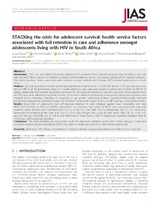STACKing the odds for adolescent survival: health service factors associated with full retention in care and adherence amongst adolescents living with HIV in South Africa
Date
2018Author
Cluver, Lucie D.
Pantelic, Marija
Toska, Elona
Orkin, Mark
Casale, Marisa
Bungane, Nontuthuzelo
Sherr, Lorraine
Metadata
Show full item recordAbstract
INTRODUCTION: There are two million HIV-positive adolescents in southern Africa, and this group has low retention in care and
high mortality. There is almost no evidence to identify which healthcare factors can improve adolescent self-reported retention.
This study examines factors associated with retention amongst antiretroviral therapy (ART)-initiated adolescents in South
Africa.
METHODS: We collected clinical records and detailed standardized interviews (n = 1059) with all 10- to 19 year-olds ever initiated
on ART in all 53 government clinics of a health subdistrict, and community traced to include lost-to-follow-up (90.1% of
eligible adolescents interviewed). Associations between full self-reported retention in care (no past-year missed appointments
and 85% past-week adherence) and health service factors were tested simultaneously in sequential multivariate regression and
marginal effects modelling, controlling for covariates of age, gender, urban/rural location, formal/informal housing, maternal
and paternal orphanhood, vertical/horizontal HIV infection, overall health, length of time on ART and type of healthcare facility.
RESULTS: About 56% of adolescents had self-reported retention in care, validated against lower detectable viral load
(AOR: 0.63, CI: 0.45 to 0.87, p = 0.005). Independent of covariates, five factors (STACK) were associated with improved
retention: clinics Stocked with medication (OR: 3.0, CI: 1.6 to 5.5); staff with Time for adolescents (OR: 2.7, CI: 1.8 to 4.1);
adolescents Accompanied to the clinic (OR: 2.3, CI: 1.5 to 3.6); enough Cash to get to clinic safely (OR: 1.4, CI: 1.1 to 1.9);
and staff who are Kind (OR: 2.6, CI: 1.8 to 3.6). With none of these factors, 3.3% of adolescents reported retention. With all
five factors, 69.5% reported retention.
CONCLUSIONS: This study identifies key intervention points for adolescent retention in HIV care. A basic package of clinic and
community services has the potential to STACK the odds for health and survival for HIV-positive adolescents.

